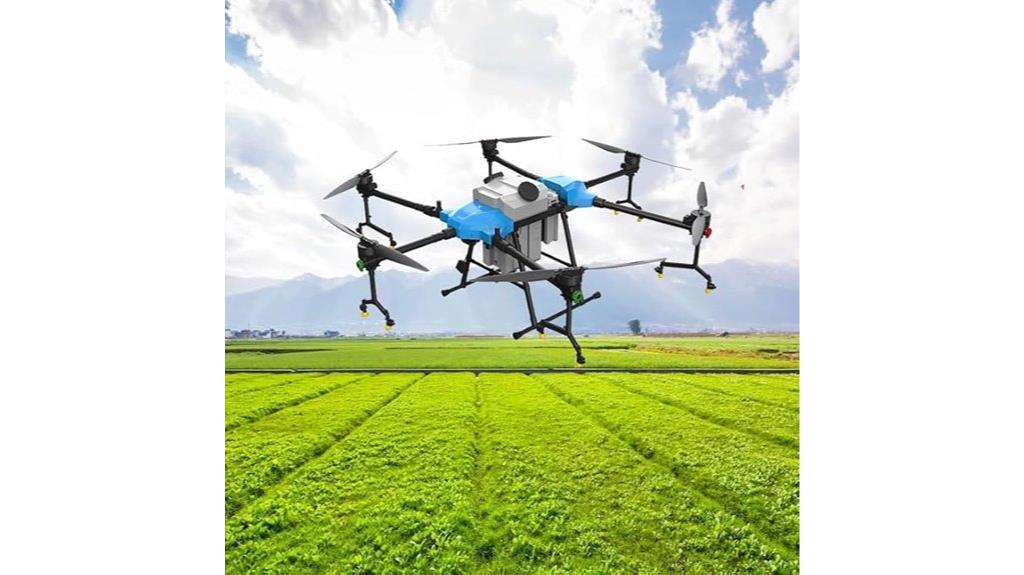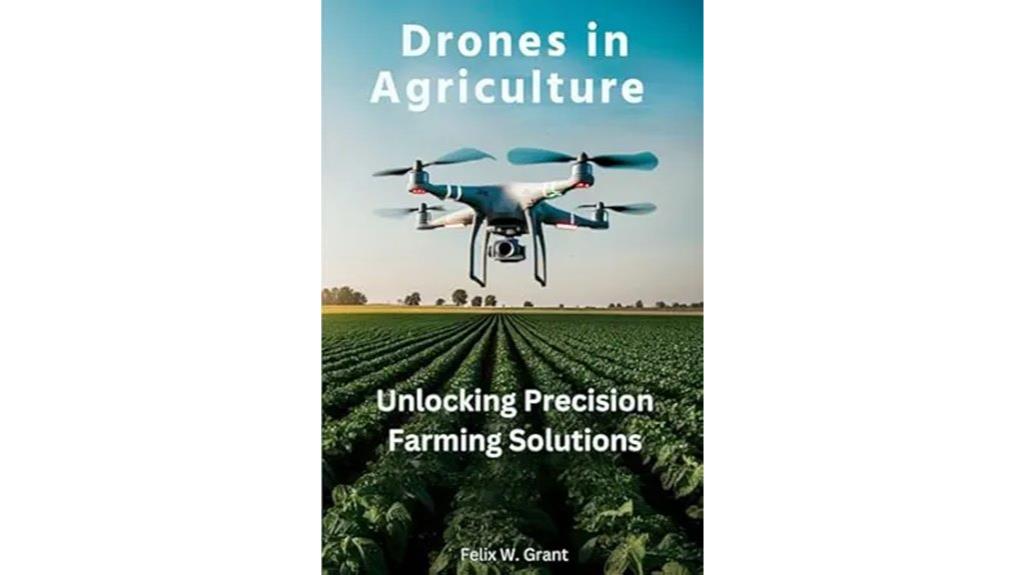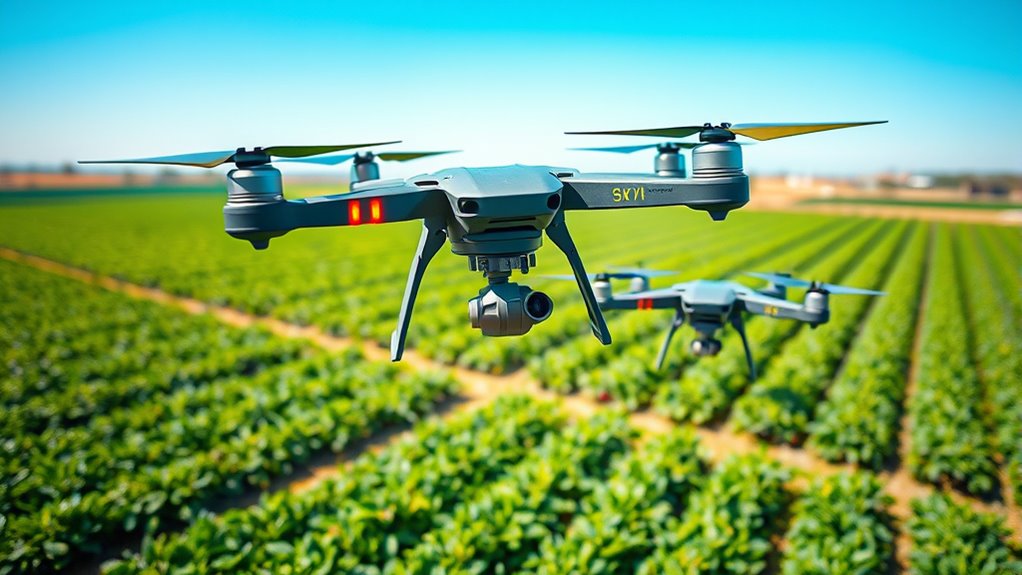If you want to boost your farming efficiency in 2025, consider the Heavy Lift 30KG Payload drone for large-scale spray tasks, the DJI P4 Multispectral drone for detailed crop analysis, and versatile agricultural drones offering precision farming solutions. Each excels in payload capacity, imaging, and automation to make your work safer and faster. Want to discover how these drones can transform your farm? Keep exploring to find out more.
Key Takeaways
- Heavy Lift 30KG Payload Drone offers high capacity for spraying and fertilization with auto flight and terrain-following features.
- DJI P4 Multispectral Drone provides advanced multispectral imaging and centimeter-level GPS for precise crop analysis.
- Both drones support automated operations, improving efficiency and reducing manual effort in farming tasks.
- Consider payload capacity, flight duration, and imaging technology to match specific agricultural needs.
- Regular maintenance, safety features, and regulatory compliance are essential for reliable, long-term drone deployment.
Heavy Lift 30KG Payload Remote Control Agricultural Drone

If you’re looking for a reliable drone that can handle large-scale crop spraying, the Heavy Lift 30KG Payload Remote Control Agricultural Drone is an excellent choice. It supports auto flight, A-B point operation, and one-button takeoff and landing for safety and efficiency. With terrain following, radar detection, and stable hovering, it adapts well to uneven terrains. Its spray system covers 6-8 meters wide with flow rates up to 10L/min, making it highly efficient. Powered by a strong 51.8V battery, it can operate for up to 25 minutes, covering half an acre per minute. This drone’s payload capacity and advanced features make it ideal for large farms.
Best For: Large-scale farmers and agricultural professionals seeking efficient, reliable crop spraying with high payload capacity and advanced terrain adaptability.
Pros:
- Supports auto flight, A-B point operation, and one-button takeoff/landing for enhanced safety and ease of use
- Equipped with terrain following, radar detection, and stable hovering for precise application on uneven terrains
- High payload capacity of 30kg and spray coverage of 6-8 meters, increasing spraying efficiency across large areas
Cons:
- Limited operational time of 8-10 minutes with a full tank, which may require multiple refills for extensive fields
- Relatively large folding dimensions may require significant storage space
- Charging time of 25-50 minutes could impact quick turnaround during busy farming schedules
Drones in Agriculture: Unlocking Precision Farming Solutions

Agriculture Drones 2025 is the ideal resource for farmers and agribusiness professionals enthusiastic to adopt precision farming solutions. I’ve seen how drone technology transforms farms by increasing crop yields, lowering costs, and promoting sustainability. Using GIS, GPS, and data analytics, drones enable precise crop and livestock management, making farming more efficient. Real-world case studies show remarkable success, proving drones can revolutionize modern agriculture. As technology advances, future trends will further shape precision farming. I encourage you to explore how selecting the right equipment and implementing practical operations can access the full potential of drones, taking your farming practices to the next level.
Best For: farmers and agribusiness professionals seeking to enhance crop management, reduce costs, and promote sustainable practices through advanced drone technology.
Pros:
- Enables precise crop and livestock management with GIS, GPS, and data analytics
- Increases crop yields while lowering operational costs
- Promotes sustainable farming practices through targeted interventions
Cons:
- Initial investment in high-quality drones and equipment can be costly
- Requires training and ongoing maintenance for optimal performance
- Regulatory restrictions and airspace regulations may limit drone deployment in certain areas
DJI P4 Multispectral Agriculture Drone

Looking for a drone that offers pinpoint accuracy in crop analysis? The DJI P4 Multispectral Agriculture Drone is designed for exactly that. It features a 3-axis stabilized multispectral camera system with RGB and five spectral sensors, including Red Edge and NIR, for extensive vegetation insights. With global shutter technology, it captures clearer images even in bright conditions. Its RTK module provides centimeter-level GPS precision, ideal for mapping and data accuracy. Plus, real-time NDVI viewing and the TimeSync system ensure precise data alignment. With a 27-minute flight time and a 4.4-mile transmission range, this drone is a powerful tool for modern farming.
Best For: farmers, agricultural researchers, and environmental professionals seeking highly accurate crop analysis and vegetation monitoring.
Pros:
- Advanced multispectral imaging with RGB and five spectral sensors for comprehensive vegetation insights
- Global shutter technology ensures clearer images in bright conditions
- RTK module provides centimeter-level GPS accuracy for precise mapping and data collection
Cons:
- Limited flight time of up to 27 minutes may require multiple sorties for extensive coverage
- High price point reflecting professional-grade features, potentially limiting accessibility for casual users
- Large size and weight (7 pounds) may require careful handling and transportation
Factors to Consider When Choosing Agriculture Drones

When selecting an agriculture drone, I focus on key factors like payload capacity and flight range to match my operational needs. I also consider imaging technology features for accurate data collection and guarantee the drone is easy to operate and maintain. Balancing these aspects helps me choose a reliable drone that fits my farming requirements efficiently.
Payload Capacity Needs
How do you determine the right payload capacity for your agricultural drone? First, assess your typical tasks—whether crop spraying, seed dispersal, or fertilizer application—and identify the maximum payload needed for those operations. It’s smart to choose a drone with a capacity that exceeds your current requirements, providing room for additional equipment or future growth. Make certain the drone can handle attachments like spray tanks, sensors, or cameras without compromising performance. Keep in mind that heavier loads can reduce flight time and battery life, so balance payload capacity with operational efficiency. Finally, select a drone with enough robustness to ensure stability, precision, and safety during high-load tasks, ultimately boosting your farming productivity and flexibility.
Flight Duration Range
Choosing the right flight duration for your agricultural drone is vital because it directly affects how efficiently you can monitor fields and perform tasks without frequent battery swaps. Typically, drones offer flight times between 8 and 27 minutes, depending on payload and battery capacity. To maximize coverage, especially over large fields, longer flight durations are preferable, with a 20-minute flight covering roughly half an acre at standard speeds. High-capacity batteries are essential if you’re carrying heavy payloads like fertilizers or pesticides, as they extend flight time. Additionally, shorter recharge times enable more continuous operation, making your workflow smoother. Balancing battery life, payload weight, and recharge efficiency ensures you get the most out of each flight, boosting overall farming productivity.
Imaging Technology Features
Selecting the right imaging technology for your agricultural drone is essential because it determines the quality and usefulness of the data collected. I look for drones with multispectral, RGB, thermal, or hyperspectral sensors, depending on my crop monitoring needs. The resolution and sensor size matter because higher quality images reveal subtle differences in crop health, helping me identify issues early. I prefer drones with global shutter sensors, as they minimize distortion during movement, ensuring accurate data. Real-time viewing features, like NDVI visualization, allow me to assess crop conditions instantly while flying, saving time. Compatibility with advanced data processing tools is also vital, as it helps me analyze images efficiently and make informed decisions to boost my farm’s productivity.
Ease of Operation
When it comes to deploying agricultural drones effectively, ease of operation plays a key role in ensuring smooth and efficient workflows. I look for drones with intuitive controls and user-friendly interfaces that shorten the learning curve. Automated features like auto takeoff, landing, and waypoint navigation make daily tasks simpler and save time. Clear pre-flight checklists and troubleshooting guides are essential, helping users of all experience levels deploy drones safely. Remote control systems that are straightforward to set up and require minimal configuration reduce operational complexity and training effort. Safety features such as one-button emergency landing or return-to-home functions boost confidence during operation and enhance safety. Overall, a drone that’s easy to operate allows me to focus more on farming and less on managing technology.
Maintenance Requirements
Maintaining agricultural drones properly is essential for ensuring reliable performance and longevity. I recommend regular inspections of propellers, motors, and sensors for signs of wear or damage, which helps keep everything running smoothly. Monitoring battery health is critical too; degraded batteries can shorten flight times and pose safety risks, so replacing them when needed is a must. Cleaning components, especially sensors and nozzles, prevents dirt buildup that can compromise data accuracy and spraying efficiency. Firmware updates are vital—they improve stability, add new features, and address security issues. Setting up a consistent maintenance schedule that includes pre-flight checks, post-flight inspections, and routine calibrations can extend your drone’s lifespan and minimize downtime. Staying on top of these tasks ensures your drone performs at its best season after season.
Frequently Asked Questions
How Do Agriculture Drones Impact Environmental Sustainability?
Agriculture drones positively impact environmental sustainability by reducing the need for chemical inputs and optimizing resource use. I use drones to monitor crop health precisely, which minimizes pesticide and fertilizer overuse, protecting surrounding ecosystems. They also help in early detection of issues, leading to targeted interventions that save water and energy. Overall, drones promote more sustainable farming practices by making resource management smarter and less wasteful.
What Are the Legal Regulations for Drone Use in Farming?
I make certain to follow local laws and FAA regulations when using drones in farming. This includes registering my drone, flying within visual line-of-sight, and avoiding no-fly zones. I also check for any specific farm-related rules or permits required in my area. Staying compliant helps me avoid fines and ensures safe, responsible drone use that benefits both my farm and the community.
How Often Should Drones Be Maintained for Optimal Performance?
Did you know that regular drone maintenance can extend its lifespan by up to 30%? I recommend checking your drone after every 10 to 15 hours of use, especially inspecting propellers, batteries, and sensors. Monthly deep-cleanings and software updates are also essential for peak performance. Staying consistent with these routines guarantees your drone functions reliably, helping you maximize productivity and avoid costly repairs down the line.
Can Drones Be Used for Crop Disease Detection?
Absolutely, drones are great for detecting crop diseases. I use them to capture high-resolution images and multispectral data that reveal early signs of issues like fungal infections or pest damage. This tech helps me identify problems quickly, so I can act before they spread. Drones save me time and keep my crops healthier, making them an essential tool for modern farming.
What Is the Typical Lifespan of an Agricultural Drone?
Oh, the thrilling lifespan of an agricultural drone—about 3 to 5 years, give or take. I’ve seen models soar through fields only to be grounded by wear and tear, just like my last attempt at a home repair. Proper maintenance, however, can stretch that lifespan. So, if you’re ready for a high-flying, slightly fleeting investment, these drones will keep your farm buzzing for a few seasons—then it’s upgrade time!
Conclusion
In my journey through the world of agriculture drones, I’ve found that choosing the right drone delivers dynamic, dependable, and data-driven results. Whether it’s lifting loads with the Heavy Lift 30KG, revealing unique insights with multispectral magic, or mastering precision with advanced controls, these top picks prove that technology transforms farming. By balancing benefits and basics, you can boost your bounty and bring your fields to vibrant, victorious life.









